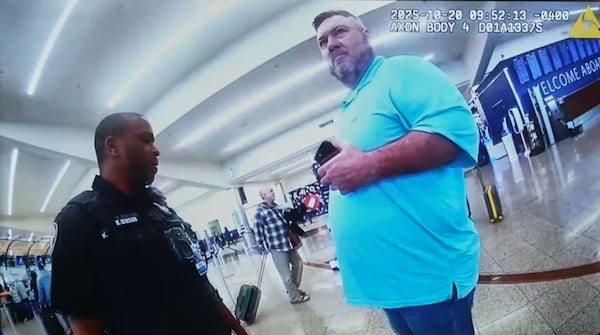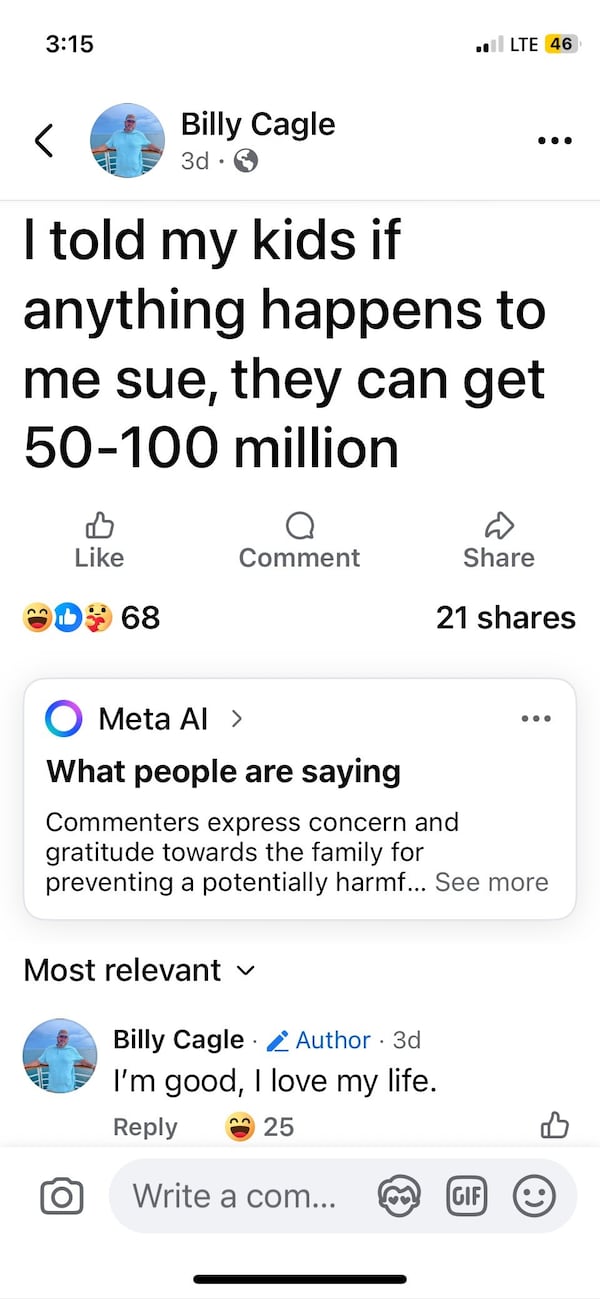Atlanta narrowly avoided being the latest city where a heavily armed man with deep grievance makes strangers pay for his troubles.
Billy Joe Cagle, a hard-working, hay-baling father of two from Cartersville, arrived at Hartsfield-Jackson Atlanta International Airport Monday morning, armed with an AR-15 in his truck, police say. And his dog.
His intentions were not good, authorities say.
He parked the vehicle in the drop-off lane outside the terminal and wandered around inside, allegedly checking out his target where he could commit maximum carnage.
Atlanta police Chief Darin Schierbaum said Cagle surveyed the TSA security checkpoint with “high interest.”
Atlanta police, acting on a call from the man’s family to Cartersville police, quickly confronted Cagle, took him to the floor and arrested the lumbering giant, averting a possible tragedy.
Whether he intended to go through with the diabolical objective will no doubt be argued in court.
He did not bring the weapon into the terminal, instead leaving it, and its 27 bullets, along with his dog, in his hastily parked truck.
Was he scoping out the best target?
Credit: AP
Credit: AP
Or was he a man on the brink of murderous act wavering under the crushing load of its awfulness?
We may never know.
In the minutes before driving the 50 miles south to Hartsfield, Cagle broadcast his intentions to a family member via Facetime, authorities say.
But he’d been melting down quietly for weeks before that, repeatedly posting photos on Facebook of a life, and a mind, that was unraveling.
His Facebook site was still up as of Thursday afternoon and had become a forum for online warriors to argue about mental health, culpability and politics (He had made some pro-Trump posts, but not many lately.)
Mostly, Cagle had posted numerous photos of a happier time when his two daughters were younger and his marriage intact.
More than a week before his trip to Hartsfield-Jackson, he posted a meme saying, “When love is real, it doesn’t lie, cheat, pretend, hurt you or make you feel unwanted.”
And he posted an “Official Girlfriend Application,” noting he’d had been married 23 years.
He had a birthday last week and posted a photo of going to dinner with his daughters.
He also got dark, noting he takes medication for schizophrenia and that he thinks someone was out to kill him.
Over the weekend, he wrote, “I told my kids if anything happens to me sue, they can get 50-100 million.”
Friends responded with concern, so he wrote: “I’m good, I love my life,” later adding “God gave me a second chance. I want to live.”
Credit: Facebook screengrab
Credit: Facebook screengrab
Nick Roberts, who played high school football with Cagle 30 years ago, called him last Sunday night, about 12 hours before his drive to the airport.
Roberts told me he thought his old teammate was suicidal.
“I think it was getting the best of him; it was like he wasn’t himself,” he said. “I never thought he was going to harm anyone. I thought he was going to do something to himself.”
“He reaffirmed that he loved his life, that he was watching TV and he was fine,” Roberts said.
As to whether Cagle would have gone through with a murderous plan? Roberts said, “We’ll never know,” adding, “He loved his daughters and I can’t see him parting with them.”
Perhaps he thought of them when he wandered the airport, deciding whether to go back and fetch his gun.
What makes someone go from a place of despair, of wanting to kill themselves, to actively taking actions to allegedly take the lives of other people — people he doesn’t even know — with them?
James Densley, a criminologist and professor at Minnesota’s Metro State University, has called such cases “angry suicides.” He also is cofounder of the Violence Prevention Project, which studies mass shootings.
“With most suicides, people want their pain to stop,” he said, and with some, “They want the world to feel it. ... It starts in private loneliness and ends with a spectacle. ‘I’m going to make myself unforgettable.’ ”
Men are said to commit about 98% of mass murders.
That is, Densley said, because men “externalize” their grievance.
Roberts told me he has concerns that Cagle’s case would take on political overtones, that “they’ll spin the narrative of a mentally ill white guy with a gun.”
Credit: AP
Credit: AP
He seemingly was a mentally ill white guy with a gun. But mass murder is not necessarily a white, Black or brown thing. “They trend pretty closely to general population levels,” Densley said.
Mother Jones magazine has tracked each mass killing since 1982, excluding “shootings stemming from more conventionally motivated crimes such as armed robbery or gang violence.”
They note 158 such slaughters. The shooters look like the fabric of America: 58% are white; 16% Black, 10% Hispanic, 6% Asian and 10% “other, unknown or native American.”
The latest census says whites are 60% of the U.S. population, Blacks are 13.4%, Hispanics 18.5% and Asians 6%.
As someone noted on Cagle’s Facebook page: “I’m so tired of people turning tragedies or near-tragedies into political talking points. This isn’t about right vs. left; it’s about humanity. One man in crisis could have caused unimaginable pain, but his family had the courage to speak up, and law enforcement acted quickly.”
Densley told me that troubled men on the brink of horror sometimes are brought back “by a simple human connection” or a family member taking action.
Fortune smiled on Atlanta. This time.
About the Author
Keep Reading
The Latest
Featured






